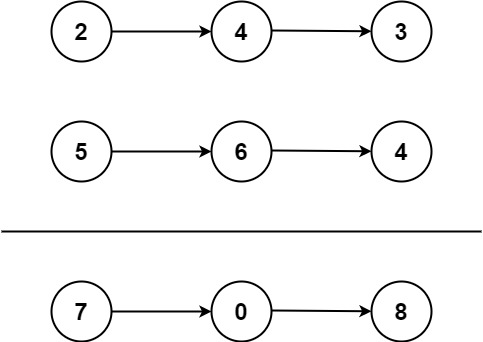LeetCode-in-All
2. Add Two Numbers
Medium
You are given two non-empty linked lists representing two non-negative integers. The digits are stored in reverse order, and each of their nodes contains a single digit. Add the two numbers and return the sum as a linked list.
You may assume the two numbers do not contain any leading zero, except the number 0 itself.
Example 1:

Input: l1 = [2,4,3], l2 = [5,6,4]
Output: [7,0,8]
Explanation: 342 + 465 = 807.
Example 2:
Input: l1 = [0], l2 = [0]
Output: [0]
Example 3:
Input: l1 = [9,9,9,9,9,9,9], l2 = [9,9,9,9]
Output: [8,9,9,9,0,0,0,1]
Constraints:
- The number of nodes in each linked list is in the range
[1, 100]. 0 <= Node.val <= 9- It is guaranteed that the list represents a number that does not have leading zeros.
Here are the steps to solve the “Add Two Numbers” problem:
Approach:
- Initialize Pointers and Carry:
- Initialize three pointers,
p1for the first linked list (l1),p2for the second linked list (l2), anddummy_headfor the dummy node of the result linked list. - Initialize
carryto 0.
- Initialize three pointers,
- Traverse Both Linked Lists:
- Traverse both linked lists until both pointers (
p1andp2) reach the end.
- Traverse both linked lists until both pointers (
- Calculate Sum and Carry:
- At each step, calculate the sum of the current digits and the carry from the previous step.
- Update
carryfor the next iteration.
- Create New Node:
- Create a new node with the value as the sum % 10 and add it to the result linked list.
- Move Pointers:
- Move both pointers (
p1andp2) to the next nodes in their respective linked lists.
- Move both pointers (
- Handle Remaining Digits:
- After both linked lists are traversed, check if there is any remaining carry.
- If there is, create a new node with the value of the carry and add it to the result linked list.
- Return Result:
- Return the next node of
dummy_headas the head of the result linked list.
- Return the next node of
Python Code:
# Definition for singly-linked list.
class ListNode:
def __init__(self, val=0, next=None):
self.val = val
self.next = next
class Solution:
def addTwoNumbers(self, l1: Optional[ListNode], l2: Optional[ListNode]) -> Optional[ListNode]:
dummy_head = ListNode()
p1, p2, current = l1, l2, dummy_head
carry = 0
while p1 or p2:
# Get values and handle None cases
x = p1.val if p1 else 0
y = p2.val if p2 else 0
# Calculate sum and carry
_sum = x + y + carry
carry = _sum // 10
# Create new node with the sum % 10
current.next = ListNode(_sum % 10)
current = current.next
# Move pointers to the next nodes
if p1:
p1 = p1.next
if p2:
p2 = p2.next
# Handle remaining carry
if carry > 0:
current.next = ListNode(carry)
return dummy_head.next
# Example Usage:
solution = Solution()
# Example 1:
l1 = ListNode(2, ListNode(4, ListNode(3)))
l2 = ListNode(5, ListNode(6, ListNode(4)))
result = solution.addTwoNumbers(l1, l2)
# Output: [7, 0, 8]
# Example 2:
l1 = ListNode(0)
l2 = ListNode(0)
result = solution.addTwoNumbers(l1, l2)
# Output: [0]
# Example 3:
l1 = ListNode(9, ListNode(9, ListNode(9, ListNode(9, ListNode(9, ListNode(9, ListNode(9)))))))
l2 = ListNode(9, ListNode(9, ListNode(9, ListNode(9))))
result = solution.addTwoNumbers(l1, l2)
# Output: [8, 9, 9, 9, 0, 0, 0, 1]
This code defines a ListNode class for the singly-linked list and a Solution class with a method addTwoNumbers that takes two linked lists as input and returns the result as a linked list. The example usage demonstrates how to create instances of the ListNode class and call the addTwoNumbers method with different inputs.

